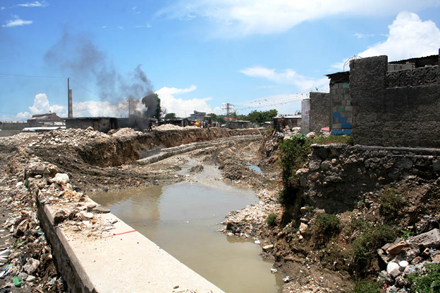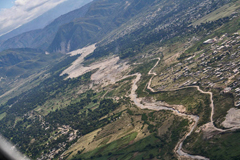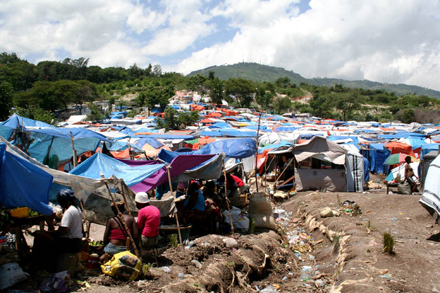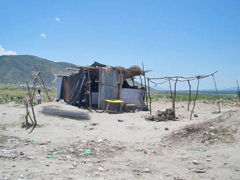Navigation
UNEP Launches New Online Resource Centre to Reduce Environmental Impact of Relief Work
Humanitarian action and relief efforts save lives and provide essential aid in the aftermath of natural disasters, conflicts and other crises. But despite this critical role, humanitarian actions can result in damage to the environment, which is not often prioritized as a life-saving issue.
 |
| Rick to human health from polluted waste water. Temporary settlements in Haiti following the January 2010 earthquake. Photograph courtesy of UNEP.Photograph courtesy of UNEP. |
Humanitarian action and relief efforts save lives and provide essential aid in the aftermath of natural disasters, conflicts and other crises. But despite this critical role, humanitarian actions can result in damage to the environment, which is not often prioritized as a life-saving issue.
A new online resource centre developed by the United Nations Environment Programme (UNEP) will help efforts to reduce the environmental impact of humanitarian relief and recovery operations around the world.
Launched on August 19, 2010, on World Humanitarian Day, the Resource Centre for Mainstreaming Environment into Humanitarian Action is the first online collection of practical information explaining how to integrate environmental considerations into humanitarian action.
The new website features guidelines, training materials, case studies and other tools and is intended as a handbook for humanitarian workers. The site can be accessed at http://postconflict.unep.ch/humanitarianaction
 |
| Dry river beds resulting from deforestation. Photograph courtesy of UNEP. |
Actions like cutting down trees to provide shelter and firewood and the inadequate management of medical waste can impact the success of both humanitarian relief and recovery activities. Additional stress placed on natural resources and livelihoods can also leave populations vulnerable to future crises.
In the eastern Democratic Republic of Congo, for example, the size and density of settlements for internally displaced persons has led to severe degradation of wildlife populations, trees and other natural resources in some areas, even encroaching on the Virunga National Park.
 |
| Shelter camps. Temporary settlements in Haiti following the January 2010 earthquake. Photograph courtesy of UNEP. Photograph courtesy of UNEP. |
Following the devastating earthquake in Haiti in January, emergency food distribution resulted in a big increase in solid and liquid waste, mainly due to packaging. Additionally, the distribution of raw food has increased the need for charcoal, which can lead to the removal of even more trees in a country with an estimated total forest cover of just 2-4%.
 |
| Temporary settlements in Haiti following the January 2010 earthquake. Photograph courtesy of UNEP. |
Making relief and recovery operations more environmentally-sound will ensure that both human welfare and the environment are protected and conserved in response to a disaster or conflict.
Several best practices have proven that including environmental considerations in humanitarian operations is not only better for the environment but also cost-effective, such as sending supplies by ship rather than by air, as well as predictable and coordinated planning of logistical operations.
 |
| Deforestation as wood is taken for shelter. Temporary settlements in Haiti following the January 2010 earthquake. Photograph courtesy of UNEP. |
UNEP has set up the resource centre in response to a clear need from humanitarian organizations for reliable and current information on incorporating environmental considerations into their policy and strategy development, program design and relief activities.
More than 150 resources from over 20 organizations are already featured on the website, arranged according to sector and environmental issue.
To ensure the resource centre provides the best available current information, UNEP is calling for contributions of resources in any language from NGOs, Governments, UN agencies, private sector and academic and research institutions.
UNEP also welcomes further feedback via email at postconflict@unep.org to make the resource centre as useful and relevant as possible for a wide range of humanitarian personnel.
UNEP will continue to work with partner organizations to ensure environmental considerations are effectively integrated in the international humanitarian system.
UNEP’s Environment, Humanitarian Action and Early Recovery Programme
UNEP is focused on ensuring that environmental issues are integrated into humanitarian action at every phase of response efforts – relief, recovery and reconstruction – in order to adequately address environmental needs in emergency and post-emergency situations.
Most humanitarian programs and operations intersect in a variety of ways with the environment, from providing shelter and protection to logistics and energy. UNEP works with humanitarian actors to build capacity and awareness to improve the way in which operations are carried out.
As part of its Disasters and Conflicts Programme, UNEP leads training, serves as the liaison with clusters and partner organizations regarding environmental issues, provides in-country expertise and facilitates policy and advocacy efforts for members of the international humanitarian
community.
Further Resources
Resource Centre for Mainstreaming Environment into Humanitarian Action --
http://postconflict.unep.ch/humanitarianaction
Disasters and Conflicts -- http://www.unep.org/conflictsanddisasters/
One Response --
http://oneresponse.info/crosscutting/environment/Pages/Environment.aspx
This news was provided by United Nations Environment Programme (UNEP), 19 August 2010.
Search
Latest articles
Agriculture
- World Water Week: Healthy ecosystems essential to human health: from coronavirus to malnutrition Online session Wednesday 24 August 17:00-18:20
- World Water Week: Healthy ecosystems essential to human health: from coronavirus to malnutrition Online session Wednesday 24 August 17:00-18:20
Air Pollution
- "Water and Sanitation-Related Diseases and the Changing Environment: Challenges, Interventions, and Preventive Measures" Volume 2 Is Now Available
- Global Innovation Exchange Co-Created by Horizon International, USAID, Bill and Melinda Gates Foundation and Others
Biodiversity
- It is time for international mobilization against climate change
- World Water Week: Healthy ecosystems essential to human health: from coronavirus to malnutrition Online session Wednesday 24 August 17:00-18:20
Desertification
- World Water Week: Healthy ecosystems essential to human health: from coronavirus to malnutrition Online session Wednesday 24 August 17:00-18:20
- UN Food Systems Summit Receives Over 1,200 Ideas to Help Meet Sustainable Development Goals
Endangered Species
- Mangrove Action Project Collaborates to Restore and Preserve Mangrove Ecosystems
- Coral Research in Palau offers a “Glimmer of Hope”
Energy
- Global Innovation Exchange Co-Created by Horizon International, USAID, Bill and Melinda Gates Foundation and Others
- Wildlife Preservation in Southeast Nova Scotia
Exhibits
- Global Innovation Exchange Co-Created by Horizon International, USAID, Bill and Melinda Gates Foundation and Others
- Coral Reefs
Forests
- NASA Satellites Reveal Major Shifts in Global Freshwater Updated June 2020
- Global Innovation Exchange Co-Created by Horizon International, USAID, Bill and Melinda Gates Foundation and Others
Global Climate Change
- It is time for international mobilization against climate change
- It is time for international mobilization against climate change
Global Health
- World Water Week: Healthy ecosystems essential to human health: from coronavirus to malnutrition Online session Wednesday 24 August 17:00-18:20
- More than 400 schoolgirls, family and teachers rescued from Afghanistan by small coalition
Industry
- "Water and Sanitation-Related Diseases and the Changing Environment: Challenges, Interventions, and Preventive Measures" Volume 2 Is Now Available
- Global Innovation Exchange Co-Created by Horizon International, USAID, Bill and Melinda Gates Foundation and Others
Natural Disaster Relief
- STOP ATTACKS ON HEALTH CARE IN UKRAINE
- Global Innovation Exchange Co-Created by Horizon International, USAID, Bill and Melinda Gates Foundation and Others
News and Special Reports
- World Water Week: Healthy ecosystems essential to human health: from coronavirus to malnutrition Online session Wednesday 24 August 17:00-18:20
- STOP ATTACKS ON HEALTH CARE IN UKRAINE
Oceans, Coral Reefs
- World Water Week: Healthy ecosystems essential to human health: from coronavirus to malnutrition Online session Wednesday 24 August 17:00-18:20
- Mangrove Action Project Collaborates to Restore and Preserve Mangrove Ecosystems
Pollution
- Zakaria Ouedraogo of Burkina Faso Produces Film “Nzoue Fiyen: Water Not Drinkable”
- "Water and Sanitation-Related Diseases and the Changing Environment: Challenges, Interventions, and Preventive Measures" Volume 2 Is Now Available
Population
- "Water and Sanitation-Related Diseases and the Changing Environment: Challenges, Interventions, and Preventive Measures" Volume 2 Is Now Available
- "Water and Sanitation-Related Diseases and the Changing Environment: Challenges, Interventions, and Preventive Measures" Volume 2 Is Now Available
Public Health
- Honouring the visionary behind India’s sanitation revolution
- Honouring the visionary behind India’s sanitation revolution
Rivers
- World Water Week: Healthy ecosystems essential to human health: from coronavirus to malnutrition Online session Wednesday 24 August 17:00-18:20
- Mangrove Action Project Collaborates to Restore and Preserve Mangrove Ecosystems
Sanitation
- Honouring the visionary behind India’s sanitation revolution
- Honouring the visionary behind India’s sanitation revolution
Toxic Chemicals
- "Water and Sanitation-Related Diseases and the Changing Environment: Challenges, Interventions, and Preventive Measures" Volume 2 Is Now Available
- Actions to Prevent Polluted Drinking Water in the United States
Transportation
- "Water and Sanitation-Related Diseases and the Changing Environment: Challenges, Interventions, and Preventive Measures" Volume 2 Is Now Available
- Urbanization Provides Opportunities for Transition to a Green Economy, Says New Report
Waste Management
- Honouring the visionary behind India’s sanitation revolution
- Honouring the visionary behind India’s sanitation revolution
Water
- Honouring the visionary behind India’s sanitation revolution
- Honouring the visionary behind India’s sanitation revolution
Water and Sanitation
- Honouring the visionary behind India’s sanitation revolution
- Honouring the visionary behind India’s sanitation revolution

